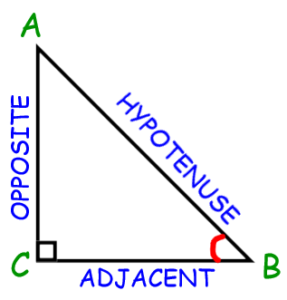I love the way these three words relate to God and the right triangle: Sin, Cos, and Tan.
Sin is opposite to God’s will, but as Christians, we still have Jesus as our foundation. Sin x = opposite/hypotenuse.
Cos is when we are in God’s will. We are “co” working together to create the angle. Cos x = adjacent/hypotenuse.
Tan, God, in His infinite grace toward us, takes our sin and our willingness to work with Him (do His will) and creates a right angle. Tan x = opposite/adjacent.

When you look at the Sin function, you will notice it is opposite angle B. It doesn’t touch the angle. When we sin, we are opposite God’s will.
🞂God’s directions are all in math. He has order to all things. Sin separates us from God; we are the opposite of His will. We don’t create fellowship with Him when we sin; we break it. When you look at the sin of an angle, it is the opposite over the hypotenuse. As Christians, we have God as our foundation, but when we sin, we are opposite His will.
When you look at the Cos function, you will notice it is working with the hypotenuse to create angle B.
Cosine (cos): We are adjacent to God’s will. You are creating the angle as you do God’s will. This is like the perfect will of God. For us to be used by Him to create something of our lives.
🞂The ‘co’ in cosine is a prefix. This prefix means together, mutually in common. Is there a better way to think of our lives without sin as being together with Jesus? So when you realize you are mutually creating an angle with the adjacent side and with the foundation (hypotenuse), you have found cosine.
Tangent (tan) is opposite over adjacent. Jesus takes our sin and uses it for good with our willingness together (cos) to create a right angle with God. Jesus died on the cross so we could be right (a right angle) with God.
🞂He takes what the enemy meant for evil, and He turns it for good.
You meant it for evil, but God meant it for good. Genesis 50:20
